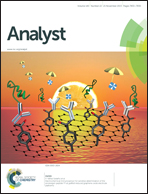An electrochemical aptasensor for detection of IFN-γ using graphene and a dual signal amplification strategy based on the exonuclease-mediated surface-initiated enzymatic polymerization
Abstract
Tuberculosis is one of the major health problems in the world. The cytokine interferon γ (IFN-γ) is associated with the disease-specific immune responses and is used as a tuberculosis diagnosis marker. In this study, a novel electrochemical aptasensor was developed for IFN-γ detection based on the exonuclease-catalyzed target recycling and the TdT-mediated cascade signal amplification. To construct the aptasensor, a previously hybridized double-stranded DNA (capture probe hybridization with a complementary IFN-γ binding aptamer) was immobilized on a gold nanoparticle–graphene (Au–Gra) nanohybrid film-modified electrode. In the presence of IFN-γ, the formation of an aptamer–IFN-γ complex leads to the liberation of the aptamer from the double-stranded DNA (dsDNA). Using exonuclease, the aptamer was selectively digested, and IFN-γ was released for the target recycling. A large amount of single-stranded capture probes formed and led to the hybridization with signal probe-labelled Au@Fe3O4. Then, the labelled signal probe sequences were catalyzed at the 3′-OH group by terminal deoxynucleotidyl transferase (TdT) to form a long single-stranded DNA structure. As a result, the electron mediator hexaammineruthenium(III) chloride ([Ru(NH3)6]3+) electrostatically adsorbed onto DNA producing a strong electrochemical signal which can be used to quantitatively measure the IFN-γ levels. With the conducting nanomaterial Au–Gra as a substrate and the target recycling-based surface-initiated enzymatic polymerization-mediated signal amplification strategy, the proposed aptasensor displayed a broad linearity with a low detection limit of 0.003 ng mL−1. Moreover, the resulting aptasensor exhibited good specificity, acceptable reproducibility and stability, which makes this method versatile and suitable for detecting IFN-γ and other biomolecules.


 Please wait while we load your content...
Please wait while we load your content...